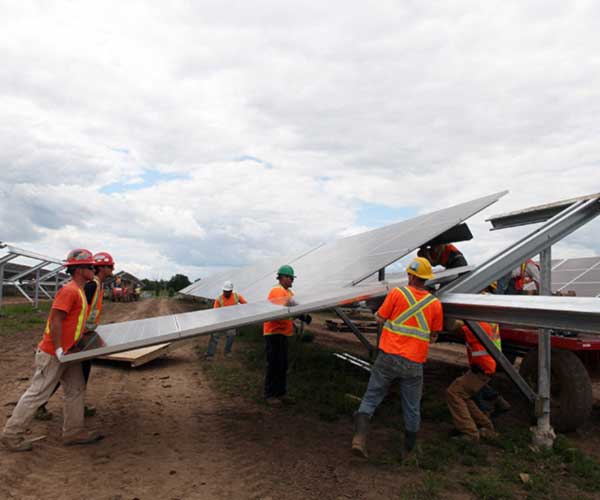Retraining Alberta’s oil and gas workers for the solar industry costs far less than you think. The results of our new study clearly show that a rapid transition to sustainable energy production is feasible, as costs of retraining oil and gas workers are far from prohibitive.
Probable futures
The oil and gas industry has played a crucial part in Alberta’s political structure for decades. Alberta contains about 97 percent of all oil stores in Canada, which ranks third globally for oil and gas exports.
Over 20 percent of the GDP and 5.9 percent of all employment in Alberta is tied to the oil and gas industry, which employs over 35,000 people.
However, many factors—including increasing electrification, reduction in renewable energy costs and climate policy—are aligning to annihilate Alberta’s traditional fossil-fuel focused energy industry. This raises a real concern for oil and gas workers’ jobs in the near future.
A confluence of events
Purchases of electric vehicles (EVs) are already up 35 percent this year after a record year, and predicted to increase. This indicates that oil-based transportation is quickly coming to an end.
In addition to lower costs of ownership, EVs can also offer electric grid support by acting like mobile batteries that can help overcome the renewable energy intermittency challenge by storing wind and solar electricity for when they are needed. In addition, conventional electric storage reduces electricity costs while servicing the grid with intermittent generators.
These technologies not only help expand opportunities for renewable energy technologies, but they also electrify transportation, which directly undermines the market for the oil industry.
Similarly, the market for the gas industry is challenged by the use of electric-powered heat pumps. In North America, solar-powered heat pumps have already become economically viable. And for the first time in history heat pump sales outperformed conventional natural gas furnaces in the United States.
Similarly, solar electricity is now the cheapest electricity to produce—and although gas-fired electricity is better for the environment and more economic than coal, gas simply cannot compete with modern solar technologies.
Competition in Alberta
Alberta allows electricity generators to sell electricity to the grid in a free market set-up. When the “pause” on renewable development in Alberta is lifted, it will create a massive solar boom.
Currently, there is a backlog of over $30 billion of hugely profitable solar projects in Alberta, poising the province for a historic surge in super-cheap solar power. Simultaneously, the costs for carbon emissions are becoming even more clear in terms of money and human deaths. This is only going to make oil and gas more expensive, whether from likely increased costs in carbon-regulated emissions or trillions in carbon emissions liabilities.
Canada’s oil sands are the most polluting type of oil produced in the world today—finding ways to feasibly phase them out is a key climate priority. If Canada makes good on its net zero by 2050 promise—essentially cutting all fossil fuel use—it is pretty clear that Alberta’s oil and gas workers will no longer have jobs.
Retraining for solar
An approach to keeping livelihoods is to retrain oil and gas workers for the solar industry, where there are lots of desperately needed jobs.
In the U.S., similar efforts are underway to retrain the 50,000 workers in the coal industry to join the more than 250,000 solar workers.
My colleagues and I completed a study on exactly what that would cost. Because many jobs in the solar industry require similar skill sets and training as general construction work, many oil and gas workers would be able to transfer fields with no additional training required.
We used the U.S. Solar Census data to examine distributions of workers that would keep the same type of work in the oil and gas industry of Alberta.
We put ourselves—figuratively—into the workboots of the oil workers to future-proof their careers. When our oil worker skills did not align directly with a position type in the solar field, workers were assigned one of a few different types of positions that would require the least retraining possible.
Multiple different retraining options were outlined—universities, colleges and online courses currently available in Alberta—to provide cost estimates for each different type of retraining: trades certification, two-year college degree, four-year university degree, graduate degree.
Retraining costs
We found the total costs for retraining all oil sands workers in Alberta for the solar industry ranges between $91.5 and $276.2 million. In context, this is a small amount of money for the energy industry—only two to six percent of federal, provincial and territorial oil and gas subsidies for a single year would need to be reallocated to provide oil and gas workers with a new career of approximately equivalent pay.
Currently, Canada spends more than $30 billion annually to fund social services for the homeless population. It makes more sense to retrain workers whose jobs are about to evaporate.
The costs to retrain oil and gas workers could be funded in many ways. For example, a Canadian CEO in the oil and gas sector could agree to reduce his annual salary to $500,000 and donate the rest for five years. That would be enough to retrain all of Alberta’s oil and gas workers.
Similarly, with fossil fuels peaking soon, companies could also prioritize retraining for their workers as they transition to carbon-free energy themselves.
Provincial and federal governments could also provide financial incentives or compensation for the costs of retraining. And finally, workers who notice the writing on the wall could start retraining at their own expense.
In the end, while there are legitimate reasons to fear for long-term employment in Canada’s oil and gas sector, the resources needed to retrain the workers for the solar industry can be easily made available for this energy transition.
—
This article is republished from The Conversation under a Creative Commons license.
![]()














Comments